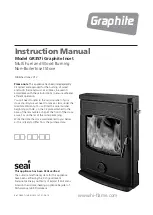
6
• Check List
Study the Packing List on page 5 and
make sure that you have received all of the
components listed before proceeding. Some
components are contained within the ash pan or will
already be fitted to the stove.
• Baffle Plate
Check the position of the baffle plate
(sometimes known as the throat plate) inside the
‘roof’ of the stove to ensure that it has not moved
during transit. This is a heavy metal plate which directs
flames and helps retain heat inside the stove.
It is best to fully familiarise yourself with the baffle
plate’s correct location by practising removing it and
re-fitting it prior to the stove’s installation as you will
need to regularly check the top of this plate and the
access to the flue way to avoid potential soot build up
and blockages. Once you know how to do this it is a
very easy operation.
See right
• Flue spigot plate
To maximise efficiency the inset
stove has been designed to work best in
conjunction with a 150mm (6”) flexible flue liner
connected to the purpose-designed spigot / plate
housed on top of the stove. To avoid soot build-up
on the stove bodywork, which could potentially ignite
and cause a chimney fire, we therefore we strongly
recommend that a liner is always used. Should it not
be possible to fit a liner then the householder should
ensure that the chimney is regularly swept and if
possible the stove removed at the same time so that
the top can be thoroughly cleaned.
• Ash Lip
The ash lip is simply fitted to the installed
stove by positioning it at the front and pushing it
underneath to make a snug fit. It can then be easily
removed for cleaning the hearth.
• Handle Assembly
Thread the split washer along
the handle bolt. Feed the bolt and washer through the
handle grip. Use a Phillips crosshead screwdriver to
attach the assembled grip to the door handle clamp
mechanism on the door, being careful not to
over-tighten.
Your inset stove is now ready for installation.
REMOVING THE BAFFLE PLATE
Regular checking of the baffle plate will ensure that
the stove’s flueway stays clear of soot as well as its
continued safe and efficient operation. If you have
never owned a stove before it is important to
understand how critical this aspect of operating a
stove is. As stated previously it is best to familiarise
yourself with this before the stove is installed. With
the Graphite Inset there are no fixing brackets, bolts
or fire bricks to remove – simply put your hand inside
the ‘roof’ of the fire chamber and push upwards. This
will release the plate which should then be pulled
forward and dropped down inside the stove ready for
inspection and cleaning.
To replace the baffle simply reverse the operation
– ensuring that the two positioning lugs (A) slide into
the retaining brackets (B) on the left and right sides
of the flueway aperture. The plate should be pushed
all the way to the back of the stove so that the final
central positioning lug (C) fits in the bracket (D).
A
B
A
A
C
D
C
The view of the
fitted baffle
from the top
(outside)
A
B







































